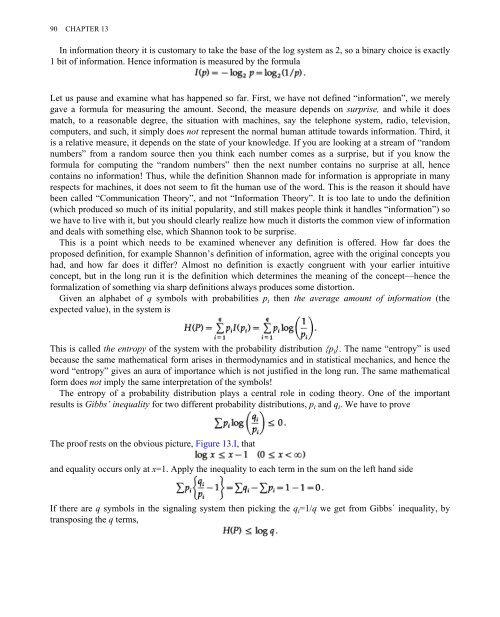hamming
hamming
hamming
You also want an ePaper? Increase the reach of your titles
YUMPU automatically turns print PDFs into web optimized ePapers that Google loves.
90 CHAPTER 13In information theory it is customary to take the base of the log system as 2, so a binary choice is exactly1 bit of information. Hence information is measured by the formulaLet us pause and examine what has happened so far. First, we have not defined “information”, we merelygave a formula for measuring the amount. Second, the measure depends on surprise, and while it doesmatch, to a reasonable degree, the situation with machines, say the telephone system, radio, television,computers, and such, it simply does not represent the normal human attitude towards information. Third, itis a relative measure, it depends on the state of your knowledge. If you are looking at a stream of “randomnumbers” from a random source then you think each number comes as a surprise, but if you know theformula for computing the “random numbers” then the next number contains no surprise at all, hencecontains no information! Thus, while the definition Shannon made for information is appropriate in manyrespects for machines, it does not seem to fit the human use of the word. This is the reason it should havebeen called “Communication Theory”, and not “Information Theory”. It is too late to undo the definition(which produced so much of its initial popularity, and still makes people think it handles “information”) sowe have to live with it, but you should clearly realize how much it distorts the common view of informationand deals with something else, which Shannon took to be surprise.This is a point which needs to be examined whenever any definition is offered. How far does theproposed definition, for example Shannon’s definition of information, agree with the original concepts youhad, and how far does it differ? Almost no definition is exactly congruent with your earlier intuitiveconcept, but in the long run it is the definition which determines the meaning of the concept—hence theformalization of something via sharp definitions always produces some distortion.Given an alphabet of q symbols with probabilities p i then the average amount of information (theexpected value), in the system isThis is called the entropy of the system with the probability distribution {p i }. The name “entropy” is usedbecause the same mathematical form arises in thermodynamics and in statistical mechanics, and hence theword “entropy” gives an aura of importance which is not justified in the long run. The same mathematicalform does not imply the same interpretation of the symbols!The entropy of a probability distribution plays a central role in coding theory. One of the importantresults is Gibbs’ inequality for two different probability distributions, p i and q i . We have to proveThe proof rests on the obvious picture, Figure 13.I, thatand equality occurs only at x=1. Apply the inequality to each term in the sum on the left hand sideIf there are q symbols in the signaling system then picking the q i =1/q we get from Gibbs´ inequality, bytransposing the q terms,


